by GaryG
If you saw my report on last November’s auction weekend in Geneva (see You Are There: Only Watch 2017 And Geneva Auction Weekend With Patek Philippe), you may recall that one of the prizes I returned home with was a vintage Patek Philippe watch: Reference 2526 in yellow gold.
Now that a bit of time has passed, and I’ve had some opportunities to get this watch into my light tent, it’s time to go back and consider how this particular piece fits into my collection, why I bought it, and why it’s quickly become a favorite of mine.
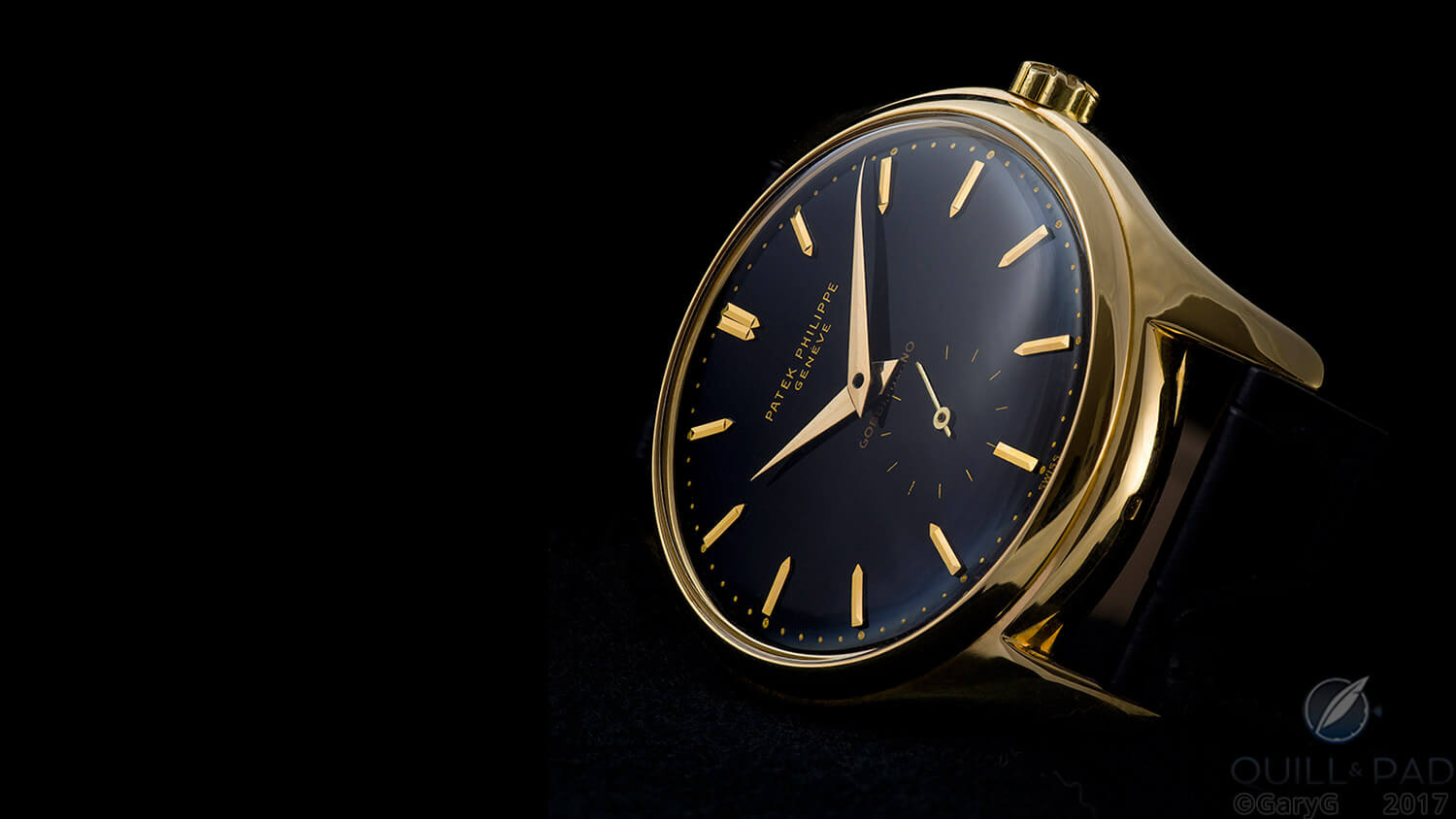
Vintage treasure: Patek Philippe Reference 2526 with black “Gobbi Milano” dial
How the Patek Philippe Reference 2526 fits
In my pal Terry’s collecting taxonomy, this piece is definitely a “foundational” item: a watch that can be an enduring element of one’s timepiece portfolio.
Over the past couple of years, I’ve been executing a conscious strategy of increasing the relative number and value of foundational watches in my collection to rebalance the mix with the significant number of “patronage” and “fun” pieces I already own. At the same time I’ve also begun to learn more about the world of vintage watches and the possibility of including vintage pieces as part of my core collection (see A Contemporary Watch Collector Goes Vintage).
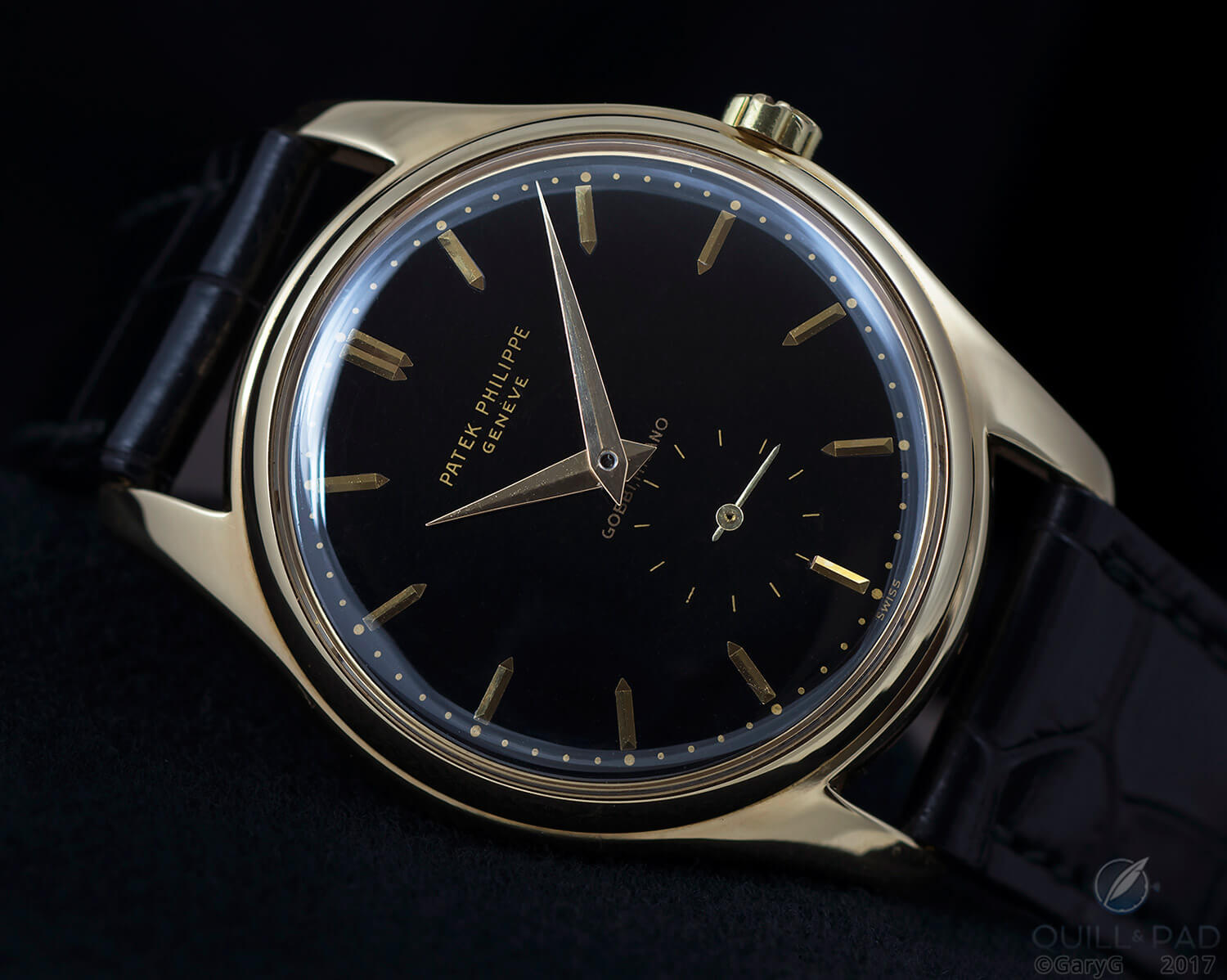
Foundational watch: Patek Philippe Reference 2526
Why and how I bought Patek Philippe Reference 2526
A good friend of mine owns a cream-dialed Reference 2526, and I’d often admired it over the years but hadn’t really understood the role that the 2526 plays in Patek Philippe’s history until talking with him and other watch pals during the trip to Only Watch 2017 and doing some late-night online research.
As I learned more, aspects of this reference that are well known to vintage enthusiasts really caught my attention: in particular the use of a fired enamel dial and the presence of Caliber 12-600 AT, Patek Philippe’s first automatic movement, a feature to which I’ll return a little later.
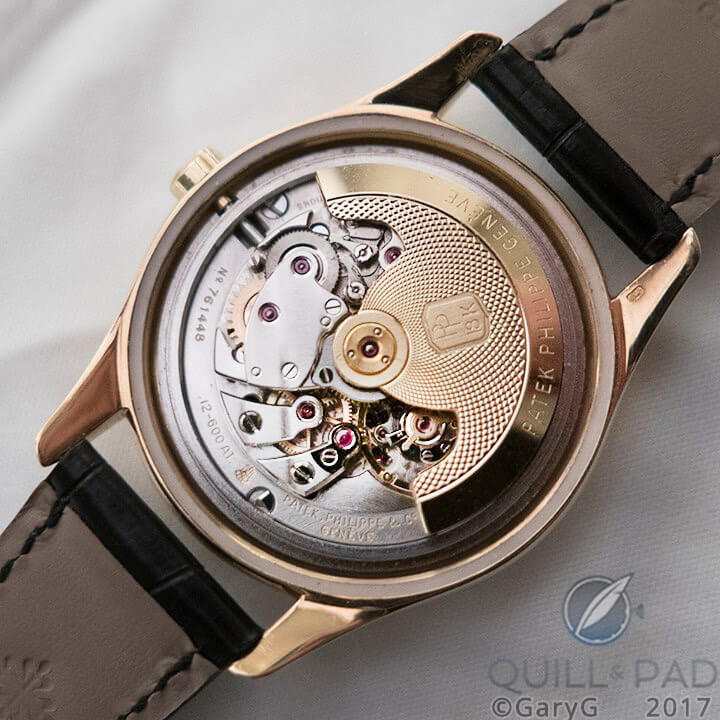
Landmark movement: Patek Philippe Caliber 12-600 AT
At dinner, a good friend who also happens to be a vintage watch expert dashed my hopes of buying the Reference 2526 I’d been eyeing at Christie’s by revealing that he would be a bidder on that piece the following day. However, that planted the seed that I might consider another watch in the same auction: a black-dialed piece signed both by Patek Philippe and Gobbi Milano, the original seller of the watch.
Two things stood in my way: first, the black-dialed piece had a significantly higher estimate than the first 2526 coupled with the fact that I’d already picked up a couple of other watches that weekend; and second, while it seemed that we’d handled and seen pretty much every watch at every auction with a loupe over the prior days, for some reason I hadn’t taken a close look at that particular lot.
As a result, I was pretty well resolved not to bid and didn’t protest when my buddy decided to step out of the auction room prior to the introduction of the lot to head off for some shopping in Geneva.
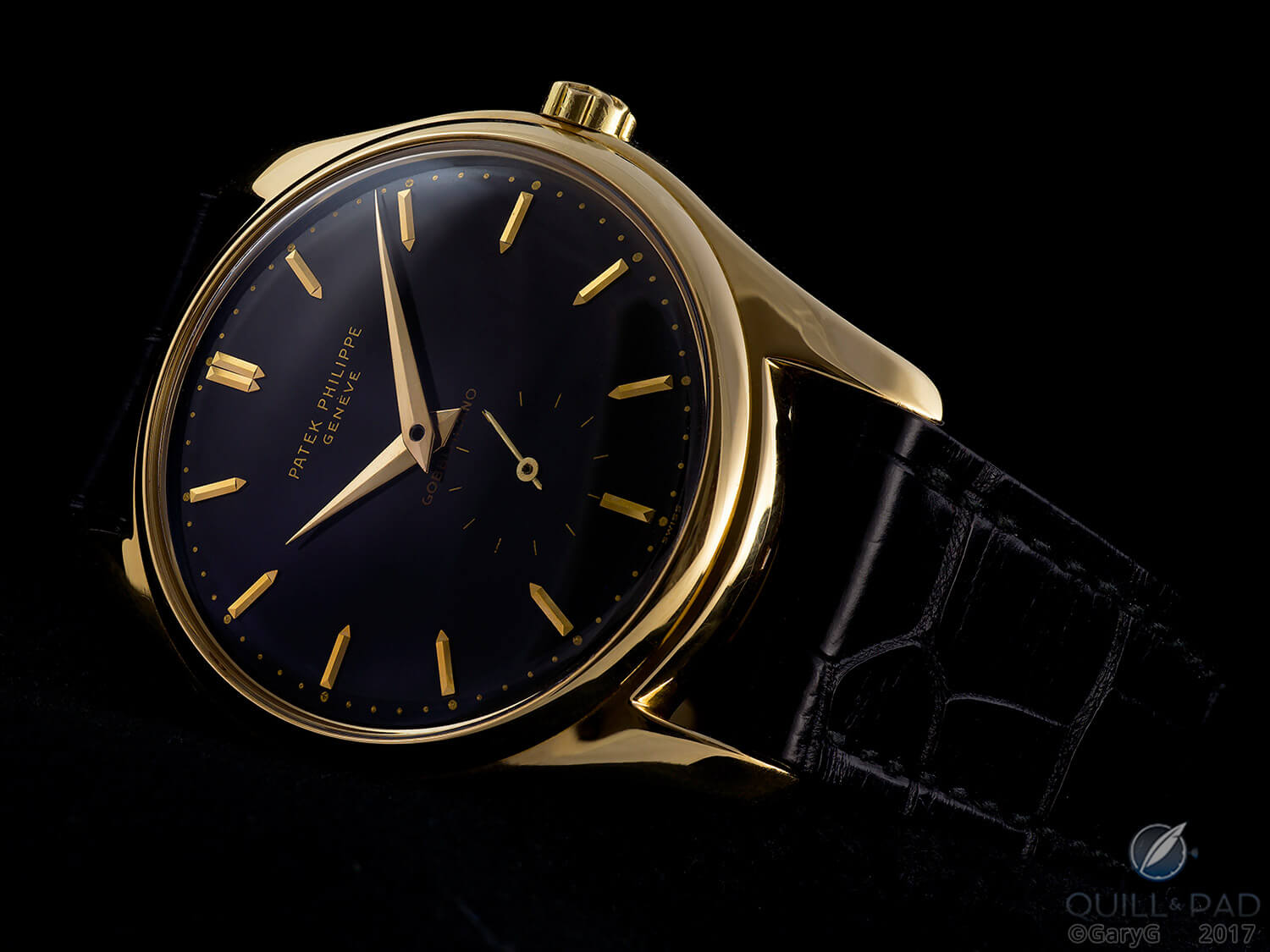
Do as I say, not as I do: Patek Philippe Reference 2526
For those of you who have read my musings on how to (and not to) bid at auction (see How I Bid: One Collector’s Approach To Buying At Watch Auctions), there’s definitely a healthy dose of “how not to” in what happened next: the bidding stalled just below the low estimate, I put up my hand, and several seconds later I was the new owner.
Why I love Patek Philippe Reference 2526
After the initial shock wore off and I had the chance to claim my prize, I started feeling great about adding this watch to my collection for several reasons:
Classic, classic, classic: while there’s some disagreement about what’s the most “classic” Patek Philippe Calatrava, in my view it’s very difficult to go wrong with Reference 2526. Everything from the case shape to the use of fired enamel for the dial to the crisp dauphine hands and pointed markers imparts a timeless feel that seems as at home on the wrist today as when this watch was sold in Milan two months before my birth.
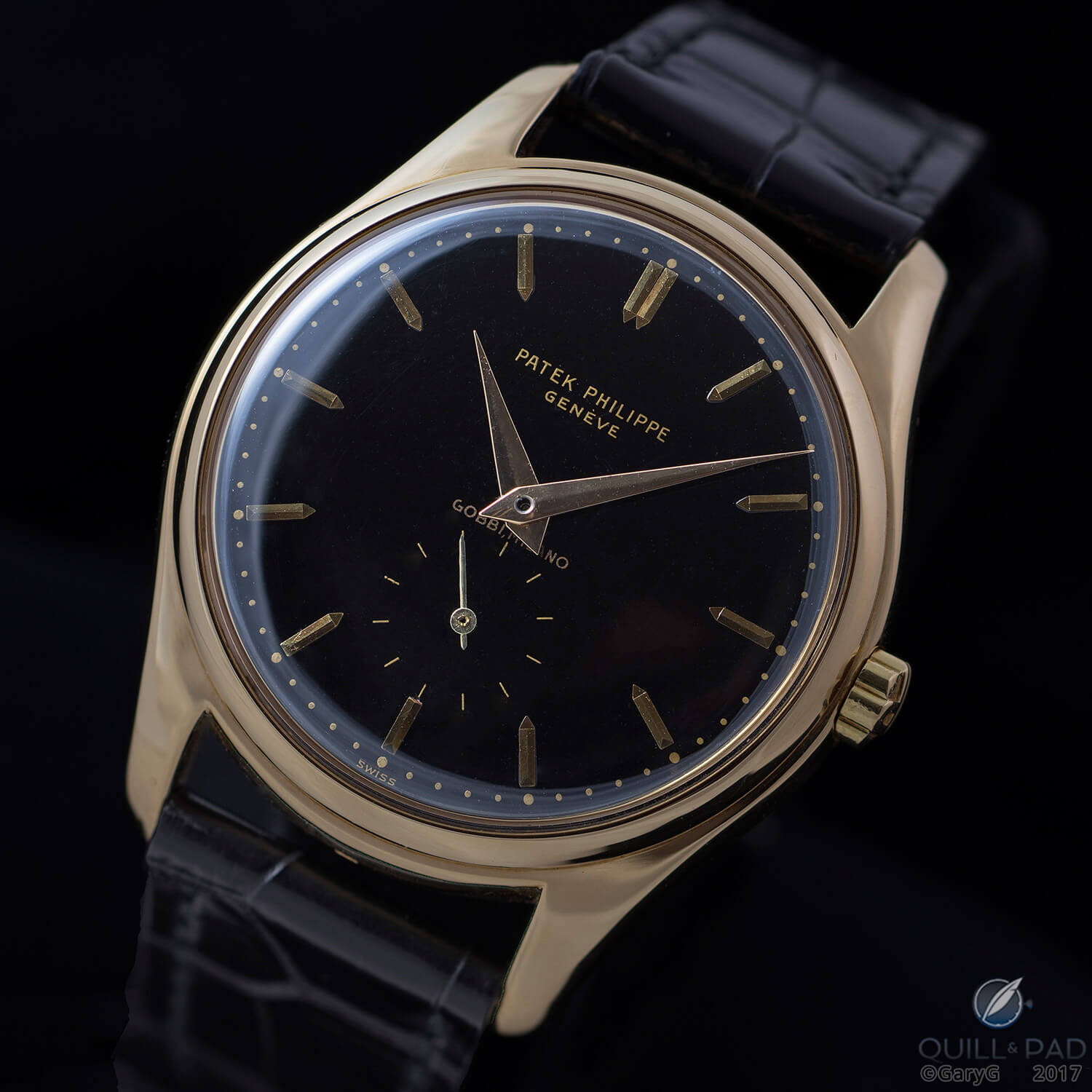
Classic looks: Patek Philippe Reference 2526 with black enamel dial
That movement: Caliber 12-600 AT was Patek Philippe’s first automatic movement, launched just after the expiration of the Rolex patent on a full-rotor self-winding movement. The guilloche work on the rotor alone is worth the price of admission, and Patek Philippe’s claim at the time that this movement would keep time to within one second per day suggests the effort exerted in its design and manufacture.
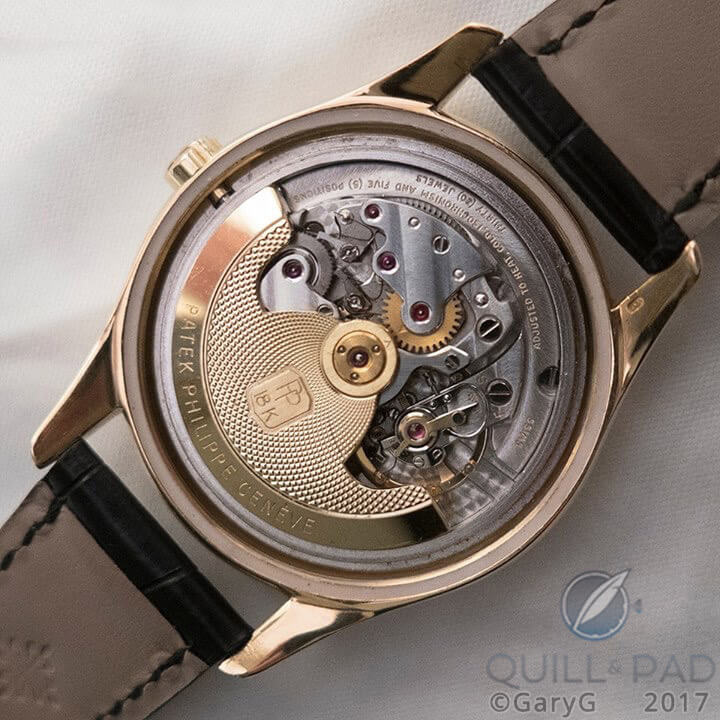
Hidden beauty: Caliber 12-600 AT with the solid case back of Patek Philippe Reference 2526 removed
Those colors: now that I own a black-with-yellow version of this watch, I somehow can’t imagine having bought a cream-dialed piece, even in my favored pink gold.
Perhaps you’ve had the experience with a given watch where one color combination just seems much better than any other. For me, examples include the A. Lange & Söhne Datograph Perpetual in white gold with grey dial, the red gold Vianney Halter Antiqua with platinum dials, the Patek Philippe Reference 5070P and 5170Ps with their unearthly blue dials, and now the Patek Philippe Reference 2526 in yellow gold with black dial.
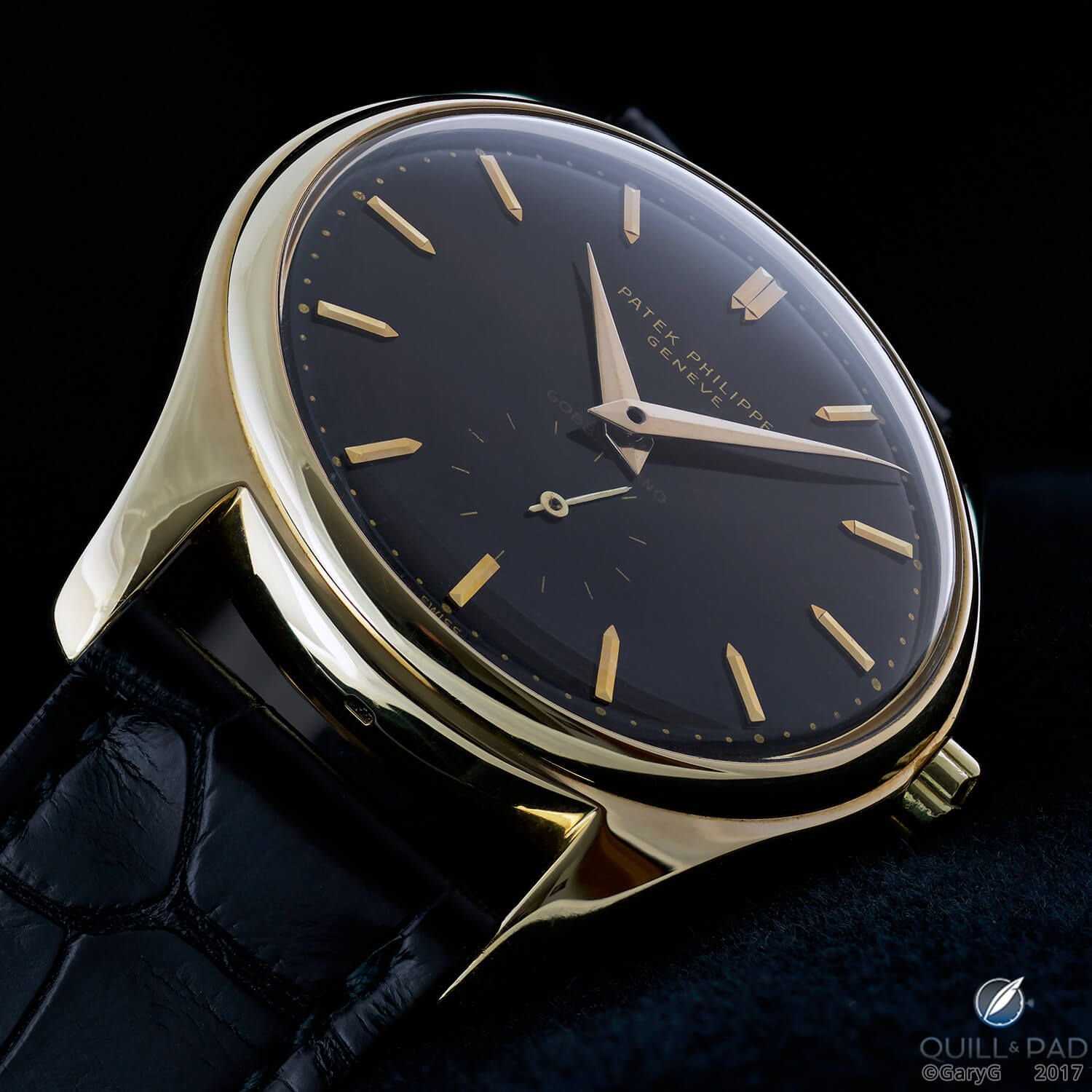
Striking colors: Patek Philippe Ref. 2526 in yellow gold with black enamel dial
In retrospect I’m even a bit surprised: as a rule I’m not strongly drawn to Patek Philippe’s yellow/black watches, but when it comes to this piece I find it difficult to tear my gaze away.
Black enamel: just as I had to ask for the Patek Philippe Reference 5370P as soon as I got sucked into its inky black enamel dial, I love checking out the dial on my 2526.
There are some differences: the “double fired” technique used in the 1950s resulted in a somewhat less perfectly flat surface than the multi-layer (and multi-firing) method used today, but I find that both the perfectly smooth brilliance of the 5370P and the slightly rougher appearance of the 2526 have their appeal.
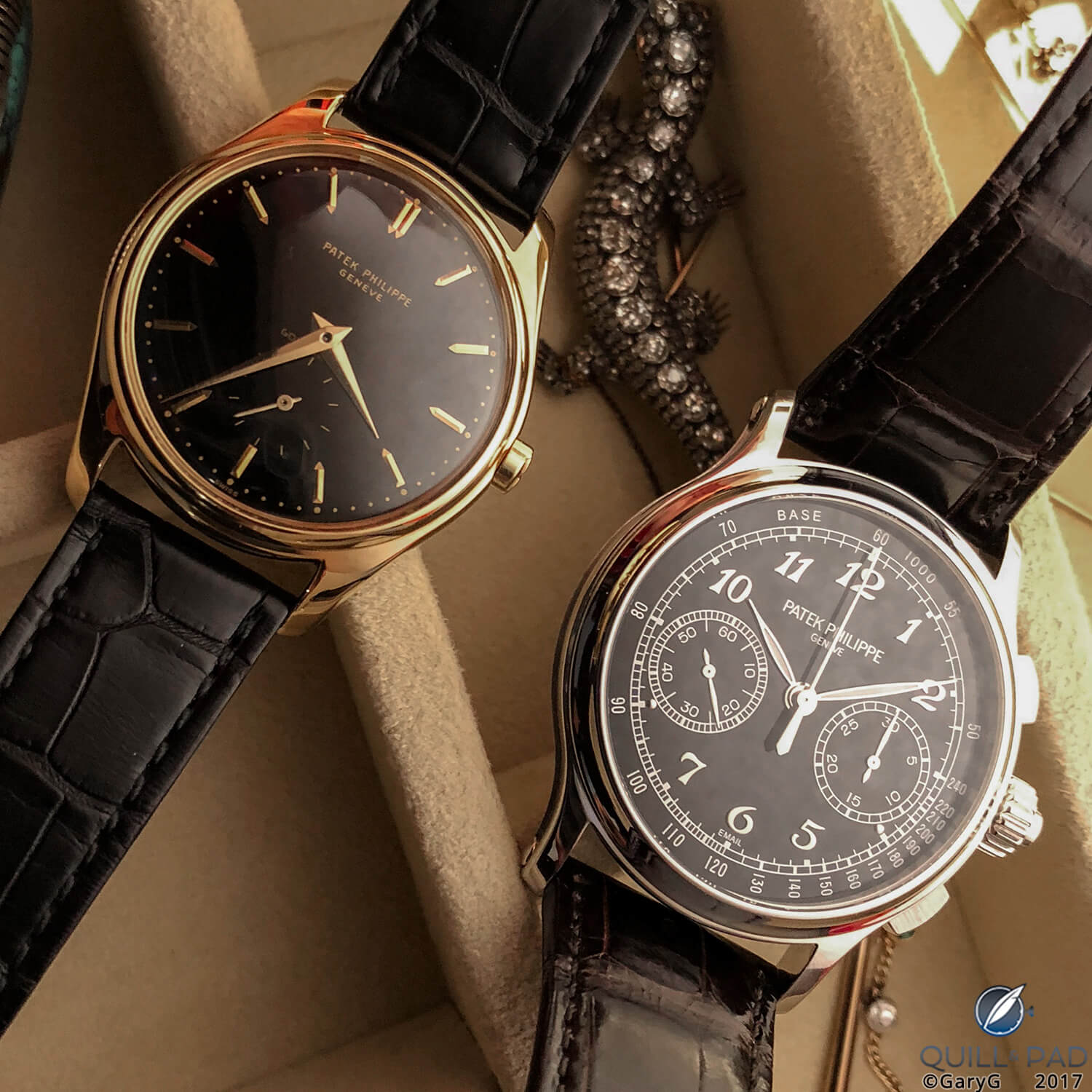
Black enamel then and now: the author’s Patek Philippe Reference 2526 and Reference 5370P
Rarity: by now, you may have noticed that in addition to its rare black dial, this watch bears another distinction: the words “Gobbi Milano” in gold just between the center of the dial and the seconds subdial.
According to Christie’s, fewer than 20 black-dialed examples of Reference 2526 have appeared at international auction. Only a few of those are certified by extracts from the company archives as having had black dials at the time of manufacture, and only two known black-dialed watches are signed by Gobbi Milano.
As it turns out, my watch is the only black-dialed Gobbi 2526 with the black dial certified on its extract as original, making it possibly unique.
Does it matter? I realize that I’m at serious risk of sliding into triple-red floating underlined Submariner land here, but at a minimum, I think it’s pretty cool to have a classic Patek Philippe watch that’s possibly unlike all the others.
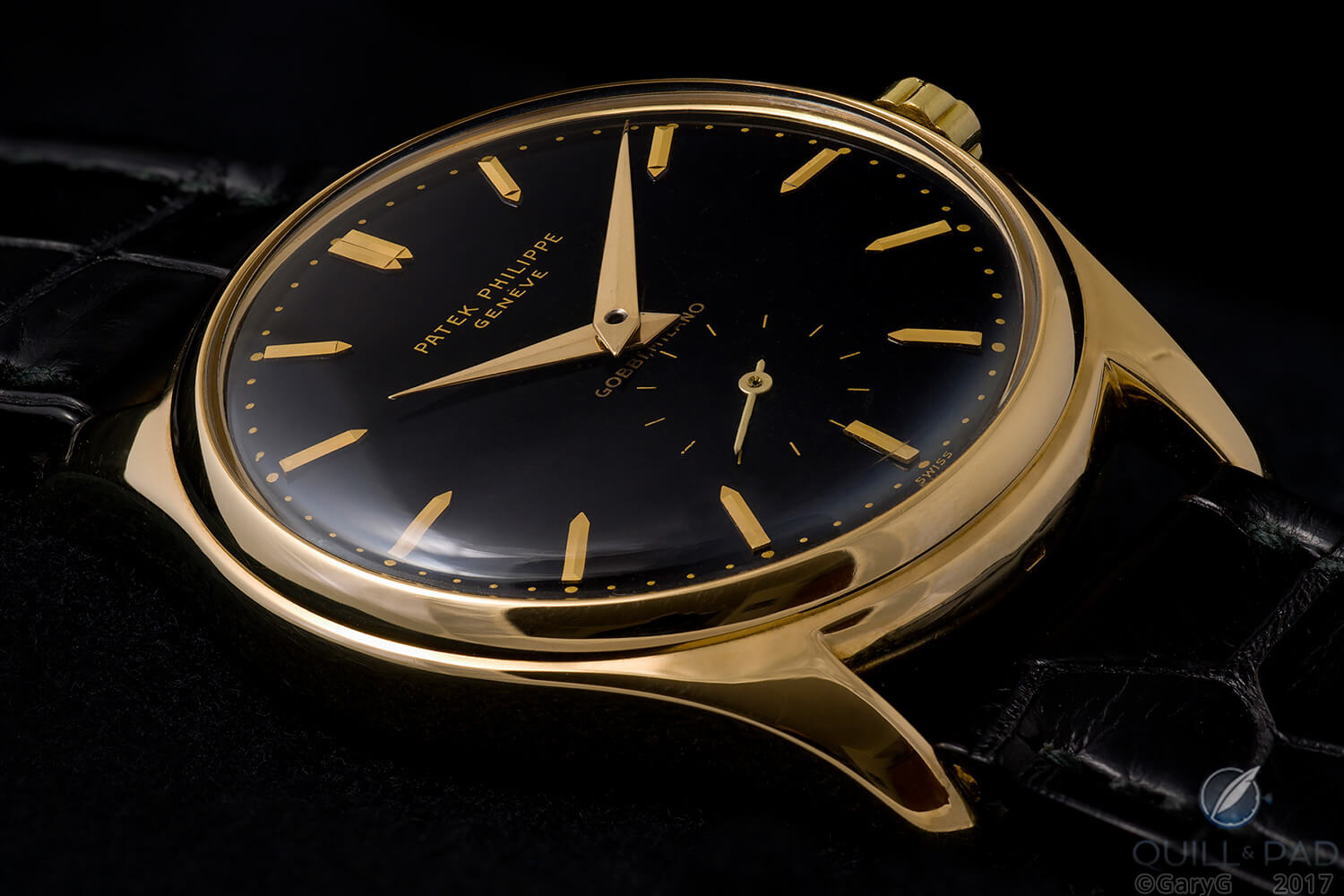
The name’s Gobbi – Gobbi Milano: double-signed Patek Philippe Reference 2526
Condition: I was justifiably nervous about the condition of this watch given that I hadn’t given it detailed scrutiny before bidding, but the condition was described as “exceptionally well preserved” in the catalogue and so far I have not been disappointed.
The case and lug shapes are clean, the edges of the polygonal case back are sharp, and the hallmarks are crisp; and when I took advantage of the auctioneer’s tendency to loosen case backs for bidder inspections and spun the back off in my hotel room, I was delighted that the water-resistant screw-down design had apparently protected the movement extremely well over the past 60-plus years.
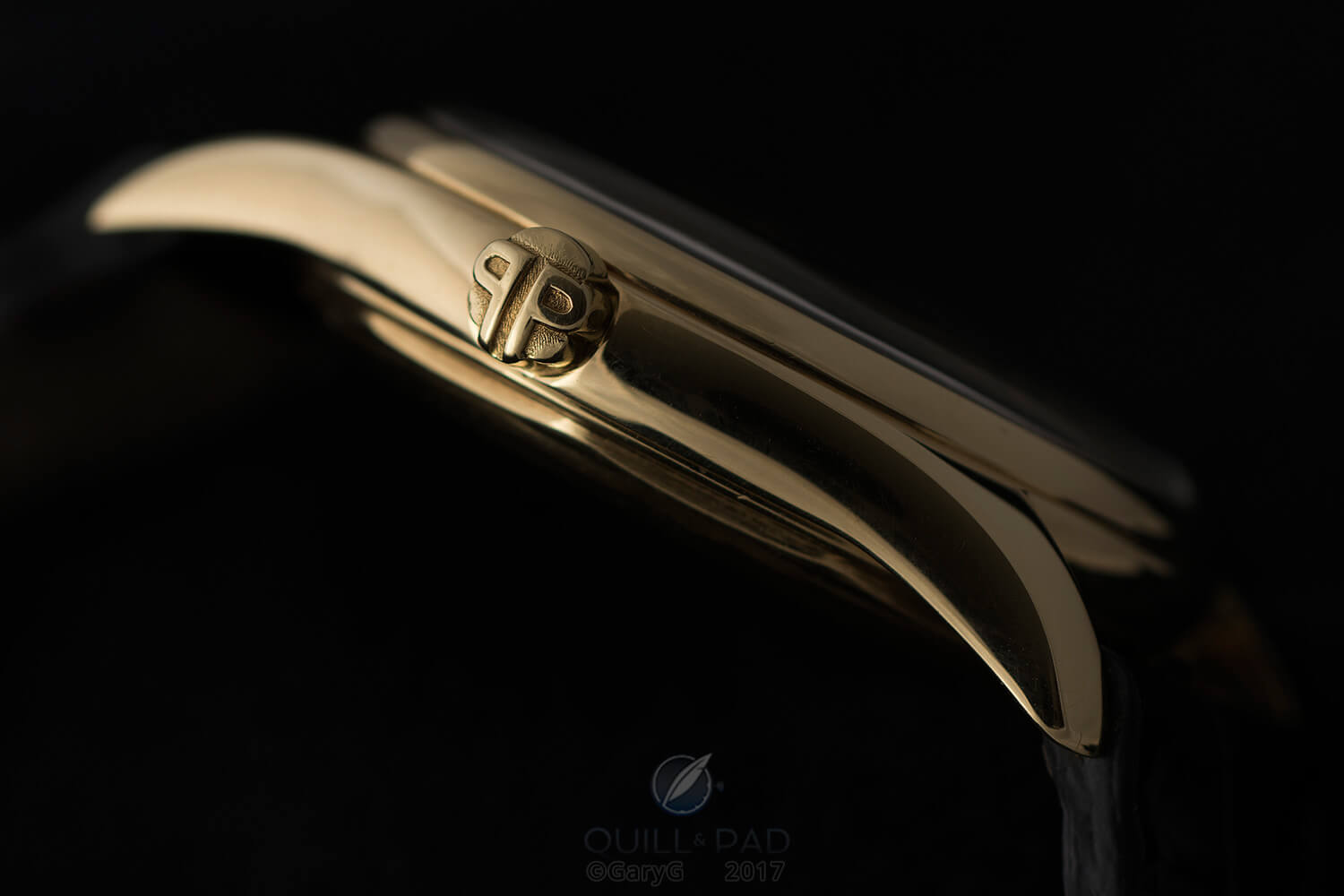
Correct and lovely: signature PP crown, Patek Philippe Reference 2526
Correctness: to the best of my knowledge, the components of this watch are all at a minimum period correct, and may in fact be original (although certifying that is well beyond my expertise and in my humble opinion claiming “new old stock” status for a decades-old watch is one rapid path to perdition). I’m particularly fond of the “PP” crown, which is one touch on this watch that is perhaps a bit less timeless than its other elements but for me gives it a bit of ’50s pizzazz.
A worthy complement: I’m an immense fan of my pink gold example of the Patek Philippe Reference 1526, the first-ever serially produced perpetual calendar wristwatch, and for me this ultra-rare classic Calatrava absolutely rises to the same level as a drool-worthy vintage Patek Philippe watch.
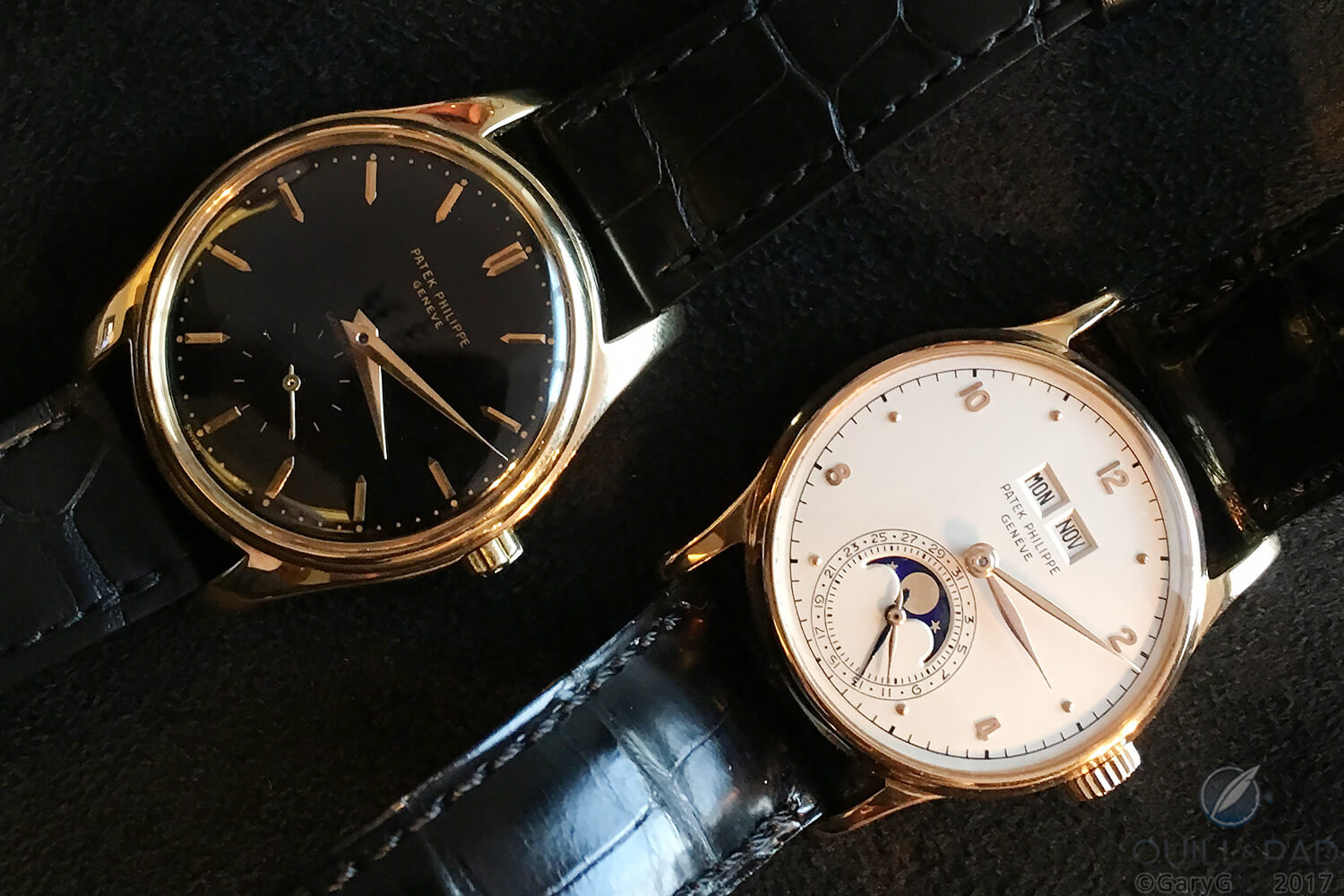
Two-watch vintage collection? Patek Philippe References 2526 (at left) and 1526
Looks good, wears great: I’ve re-measured the diameter of the 2526 several times, and it still keeps coming up 35 mm but despite its dark dial it wears larger on the wrist, perhaps due to its slim bezel and longish lugs. This is a watch that wears well, and for me can both bring a touch of class to business attire and comfortably dress down for informal wear.
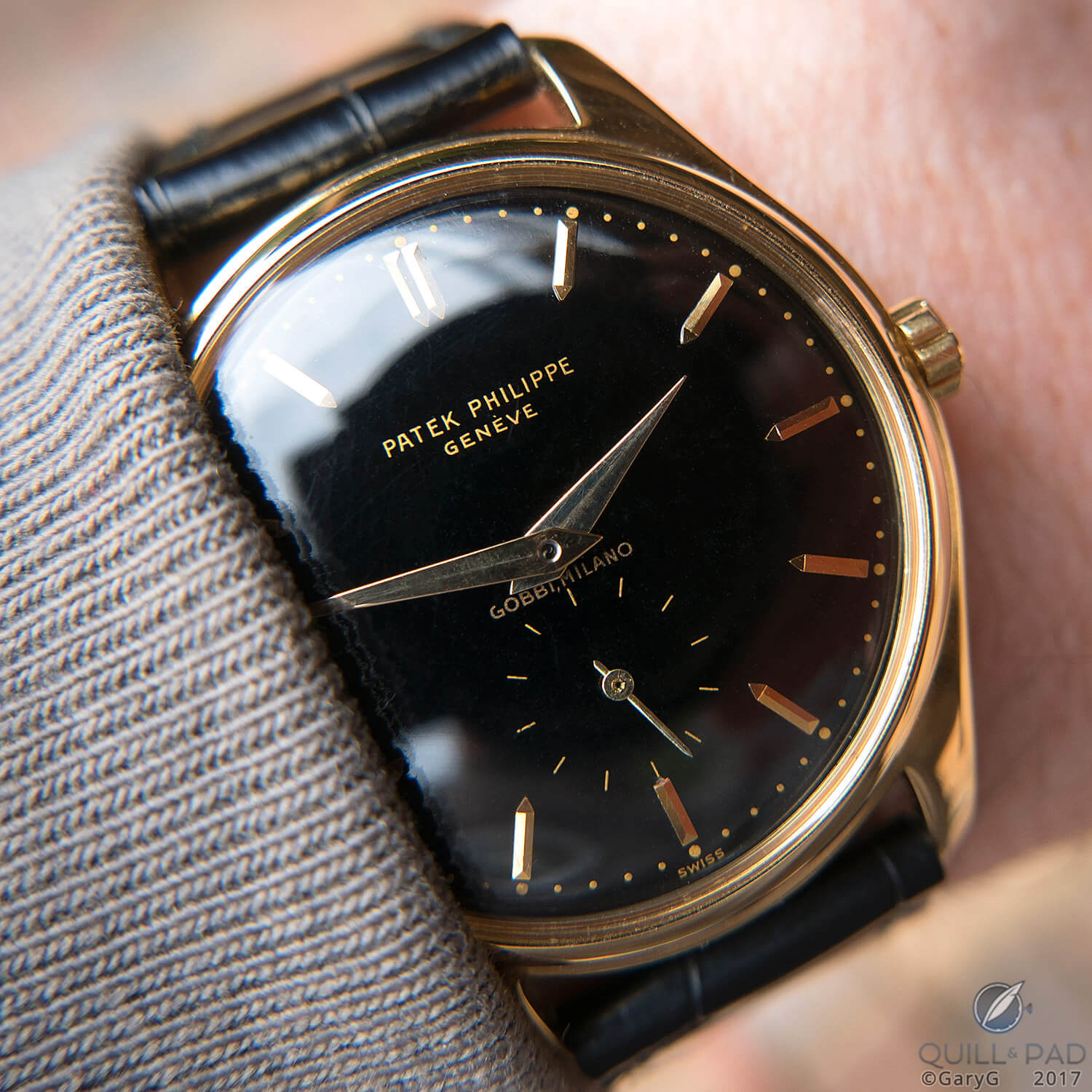
On the wrist: Patek Philippe Reference 2526 black dial “Gobbi Milano”
Might I get hurt?
You’ll recall that where I started with this watch was that in truth I really should have kept the funds I used to buy it in my savings account!
While other variants of the Reference 2526 in strong condition are available for less than I paid for this piece, I take some solace in the values we’re seeing for other double-signed Patek Philippe watches, the certified original status of my black enamel dial, and my sense that due to the order of the lots at Christie’s that day and perhaps a bit of luck I seem to have bought well, especially as less than a year prior this same watch was offered for sale by a vintage watch dealer at more than twice the price I paid.
I was also very pleased to see that only two weeks later in November, another black-dialed 2526 – this one single-signed – sold at Christie’s Hong Kong auction for 60 percent more than I paid for mine!
Perhaps the best news, though, is that at least from where I sit right now, this one is a keeper.
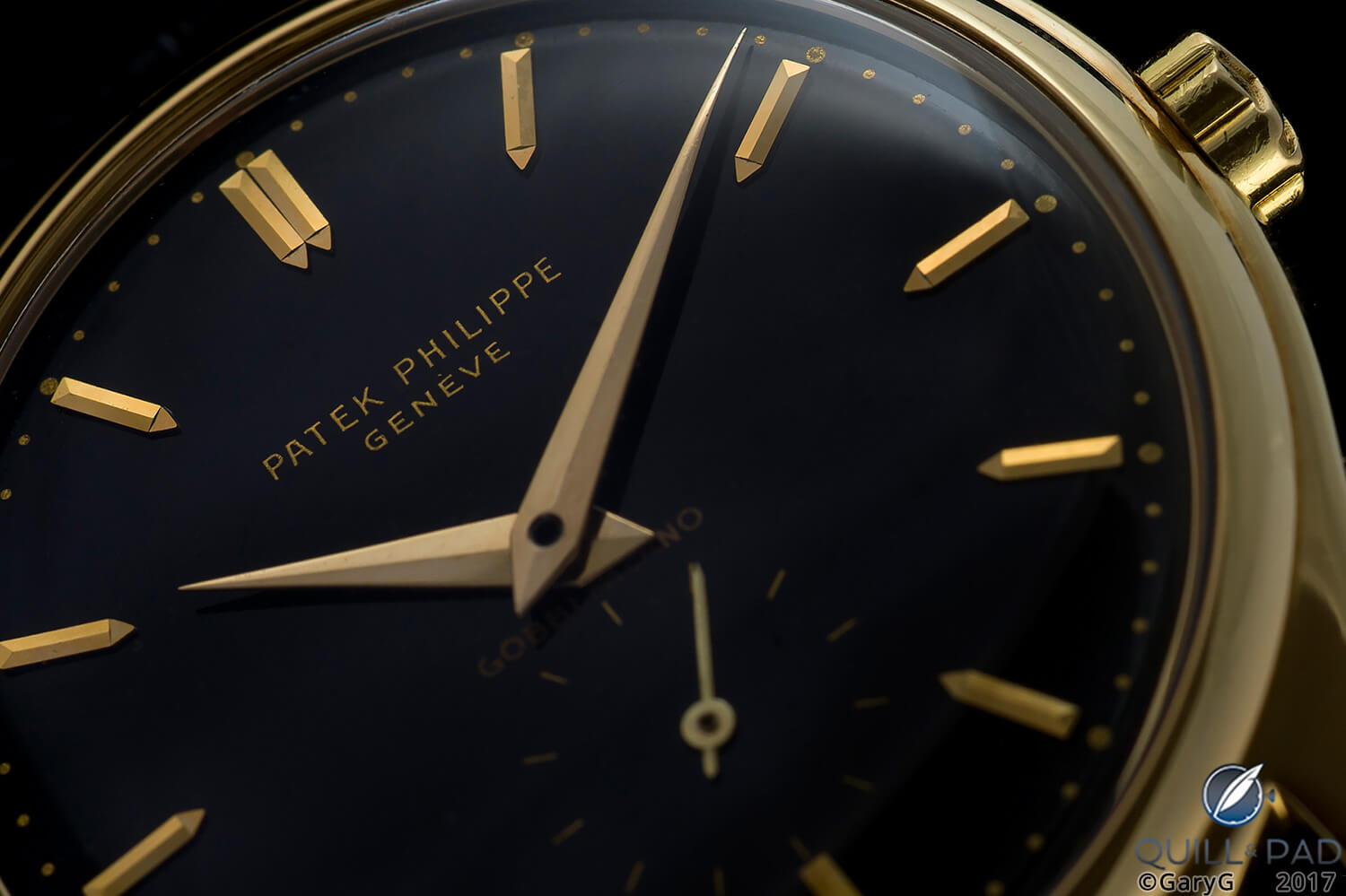
Parting shot: Patek Philippe Reference 2526 “Gobbi Milano” black dial
Quick Facts Patek Philippe Reference 2526 “Gobbi Milano” black dial
Case: 35 mm, yellow gold with solid screw-down back, PP logo crown
Dial and hands: black double-fired enamel signed by Patek Philippe and retailer Gobbi Milano; applied gold markers and gold dauphine hands
Movement: automatic Caliber 12-600 AT stamped with the Geneva Seal
Functions: hours, minutes, subsidiary seconds
Auction price: CHF 100,000 at Christie’s Geneva, November 2017
Produced: 1954
Sold: June, 1955
* This article was first published on January 12, 2018 at Why I Bought It: Patek Philippe Reference 2526 ‘Gobbi Milano’.
You may also enjoy:
Why I Bought It: Grönefeld 1941 Remontoire
Why I Bought It: Two ‘Unsalable’ Jaeger-LeCoultre Caliber 906 Prototypes
Patek Philippe Minute Repeater References 5074P And 5078P: The Great Chime-Off!
Leave a Reply
Want to join the discussion?Feel free to contribute!





















































Enamel dials do make the nicest inky black color. I agree that the color combo allows watch to be work more dressed down too.
Beautiful ref.
Beautiful, but 35mm? Thanks for the LOL
Sorry the size is not to your taste, but it’s really your loss as the Ref. 2526 is one of the great pieces in wristwatch history. And I’ll also note that pretty much all of the collectors I know wear a variety of sizes, and that watches like the recent Rolex OP36 are bringing more modestly sized watches back into the spotlight.
It is sublime.
I feel very fortunate to be the keeper of this one!